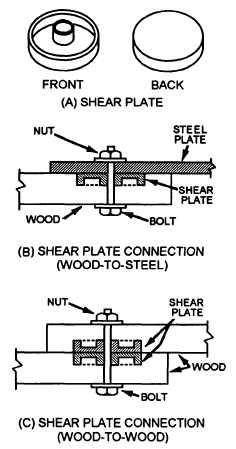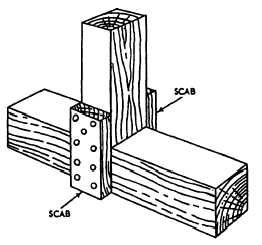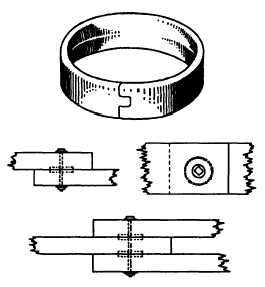Figure 1-26.—Scabs.
Figure 1-27.—Split ring and split-ring joints.
washers under both the bolt head and the nut. The bolts
are then tightened until the washers bite well into the
wood to compensate for future shrinkage. Bolts should
be spaced a minimum of 9 inches on center and should
be no closer than 2 1/2 inches to the edge or 7 inches to
the end of the timber.
Driftbolts, also called driftpins, are used primarily
to prevent timbers from moving laterally in relation to
each other, rather than to resist pulling apart. They are
used more in dock and trestle work than in trusses and
building frames. A driftbolt is a long, threadless rod that
is driven through a hole bored through the member and
into the abutting member. The hole is bored slightly
Figure 1-28.—Shear plate and shear-plate joints.
smaller than the bolt diameter and about 3 inches shorter
than the bolt length. Driftbolts are from 1/2 to 1 inch in
diameter and 18 to 26 inches long.
Butt joints are customarily connected using
driftbolts; however, another method of making
butt-joint connections is to use a scab. A scab is a short
length of timber that is spiked or bolted to the adjoining
members, as shown in figure 1-26.
TIMBER CONNECTORS
A timber connector is any device used to increase
the strength and rigidity of bolted lap joints between
heavy timbers. For example, the split ring (fig. 1-27) is
embedded in a circular groove. These grooves are cut
with a special bit in the faces of the timbers that are to
be joined. Split rings come in diameters of 2 1/2 and 4
inches. The 2 1/2-inch ring requires a 1/2-inch bolt, and
the 4-inch ring uses a 3/4-inch bolt.
Shear plates are shown in figure 1-28. These
connectors are intended for wood-to-steel connections,
as shown in view B. But when used in pairs, they may
1-15







